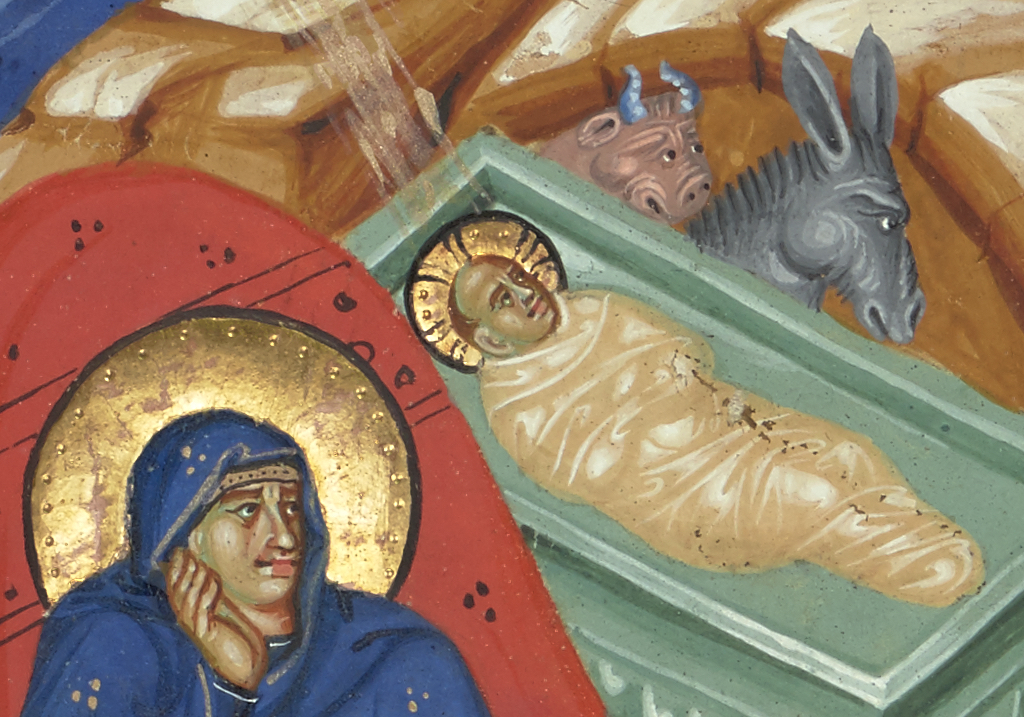Младенец и Рождество из болонской книги с песнопениями
От Рождества до Богоявления

Инициал H: Рождество, фрагмент. Антифонарий. Место создания: Болонья, Эмилия-Романья, Италия. Конец XIII века. Художник Мастер Жироны (если я правильно перевожу), работавший в Италии около 1300 года / Antiphonal. Initial H: The Nativity. Master of Gerona (Italian, active about 1300). Place created: Bologna, Emilia-Romagna, Italy. Date: late 13th century. Tempera colors, gold leaf, and ink on parchment. Leaf: 58.3 × 40.2 cm. Manuscript. Ms. Ludwig VI 6, fol. 94. Getty Museum. Source
Антифонарий /лат. antiphonarius [liber, libellus], antiphonarium или antiphonale [libellum], в латинской традиции богослужебная певческая книга, содержащая песнопения суточного круга.
Младенец лет пятидесяти двух в обществе свинобыка. Да и Дева Мария немного "на любителя". В праздник Рождества такое демонстрировать даже как-то неудобно, поэтому картинка отправляется в эфир не в первый день праздничного цикла.
Справедливости ради: инициал полностью и весь лист выглядят так:
2.

Ms. Ludwig VI 6, fol. 94. Getty Museum. Source
3.

Антифонарий. Место создания: Болонья, Эмилия-Романья, Италия. Конец XIII века. Художник Мастер Жироны, работавший в Италии около 1300 года. Лист большой: 58.3 × 40.2 см / Antiphonal. Initial H: The Nativity. Master of Gerona (Italian, active about 1300). Place created: Bologna, Emilia-Romagna, Italy. Date: late 13th century. Tempera colors, gold leaf, and ink on parchment. Leaf: 58.3 × 40.2 cm. Manuscript. Ms. Ludwig VI 6, fol. 94. Getty Museum. Source. Original (6345 x 9264)
Описание:
The H on the left side of the page introduces the chant Hodie nobis celorum rex (This day unto us the king of heaven), the first elaborate chant for the predawn service on Christmas. The representation of the Nativity within the enlarged initial heralds the theme of the chant, the celebration of Jesus' birth.
The Virgin Mary, depicted in a traditional reclining pose, and Saint Joseph, seated to the right, seem lost in contemplation of the swaddled Christ Child in a sarcophagus-like crib, a reference to his future sacrifice. Jesus directs his gaze above, where the star followed by the Magi appears as a comet whose tail leads back to the baby. Apocryphal texts described the rocky, cavelike setting and stable animals whose heads appear behind the manger. The massive, draped figures and the relatively deep, three-dimensional space are characteristic of contemporary Byzantine art. Source
О рукописи:
This large-scale, splendidly illuminated choir book was designed to be seen from the lectern by a group of singers during the Divine Office, the eight prayer services celebrated daily by monks, nuns, and clerics of the Catholic Church. It is the first volume of an antiphonal that probably consisted of seven separately bound books. The manuscript's illumination primarily takes the form of historiated initials marking each of the major holidays of the church year. The illuminator of this manuscript, known as the Master of Gerona, worked in Italy in the late 1200s. Familiar with the most recent trends in Italian panel painting and Byzantine icon painting, he knew how to convey a sense of weight, volume, and depth. Drawing on these innovations, he embedded scenes of surprising naturalism within the initials. Source
Ранее: http://gorbutovich.livejournal.com/tag/Рождество